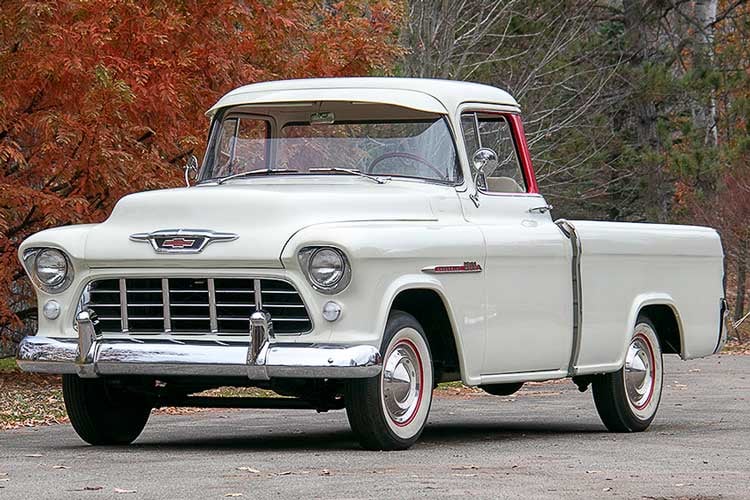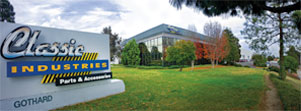
Classic trucks have curves, and that's one of the many reasons we love them. One of the main sources of this curvy appearance is their use of Stepside bed designs. Stepside trucks feature a narrow rectangular bed flanked by external fenders over the rear wheels, plus convenient step platforms behind the cab. Today, we think of this as an optional feature that fell out of favor, but in reality, the Stepside design was simply the default way trucks were made until the mid-1950s. A recent video from Rare Cars summarized the history of Stepside (a.k.a. Flareside or Utiline) truck beds and why they were eventually replaced by the Fleetside beds all modern trucks have today.
Photos courtesy of Mecum Auctions
What is a Stepside Bed?

Stepside was Chevrolet's trademarked name for its traditional truck bed design, but other manufacturers had their own names for it. GMC called it Fenderside, Ford used Flareside, and Dodge named it Utiline (a portmanteau of "utility line"). No matter the label, these beds are characterized by bed floor dimensions narrower than the width of the cab, external fenders, and side steps.

However, it's important to note that these names didn't appear until the mid-1950s. Prior to that time, these were just called truck beds because there was no alternative option!
Why Was Stepside the Standard Bed Design?

Above: This 1931 Ford Model A pickup shows an important stage in the evolution of pickup truck design, with a narrow cab and bed surrounded by separate fenders and full-length running boards.
The answer to this question may not seem obvious today. In the early 1900s, automakers sold vehicles as a bare chassis, allowing buyers to add the body of their choice. The pickup truck was born soon afterward, first with a stake bed behind the cab and later with an enclosed steel box and folding tailgate. For ease of manufacturing, these beds were narrower than the width of the axle so they wouldn't interfere with the rear wheels.

Above: This 1956 Ford F-100 Flareside still shows the lineage of the fender-and-running-board design used on earlier trucks. However, the cab and front fenders were becoming more integrated, and the full-length running boards would soon disappear.
Stepside & Fleetside Split

In 1955, Chevrolet introduced the Cameo Carrier, a design that revolutionized the pickup truck market. It still used the same bed floor dimensions, but replaced the rounded fenders and steps with a pair of sleek fiberglass fenders that mimicked the shape of the body. This made the truck look more luxurious without compromising its ability to haul cargo. However, it was expensive to manufacture, adding more than 20% to the price of a basic Chevy pickup ($1,835 Cameo vs. $1,430 base).

Above: In 1955, Chevy trucks still came standard with a Stepside bed unless the buyer paid extra for the Cameo package with fiberglass fenders.
At this point, the flat-sided bed — later called Fleetside by Chevrolet — was just a cosmetic option. Ford introduced the next step in pickup truck evolution in 1957 with its F-100 Styleside bed.

Ford's Styleside wasn't just a set of cool fenders on a traditional narrow truck bed. It expanded the width of the bed to the full width of the cab, and cut out inner wheelhouse panels to accommodate the rear wheels. This offered more cargo space within the same exterior bed dimensions.

The Final Years of the Stepside

Over the following decades, narrow-bed (e.g. Stepside) and wide-bed (e.g. Fleetside) options were offered concurrently by all of the Big Three manufacturers. However, as manufacturing cost for the Fleetside beds decreased and more consumers saw the benefits of wider beds, sales of Stepsides gradually tapered off.

By the mid 1980s, Dodge discontinued its narrow-bed Utiline option. Ford and GM continued to make narrow-bed trucks until the 2000s, including memorable examples like the 2001 F-150 SVT Lightning above, but those were also discontinued as design themes became less rounded and more boxy. Check out the video below from Rare Cars for more examples and details:
Ultimately, the "standard bed" we consider standard today started out as an experimental option that gradually evolved to take over the market. Thankfully, we're able to keep the Stepside classic trucks alive through the availability of original-style restoration parts. If you own a classic truck — whether it's Stepside or Fleetside — click the button below to see all the restoration parts Classic Industries offers:




